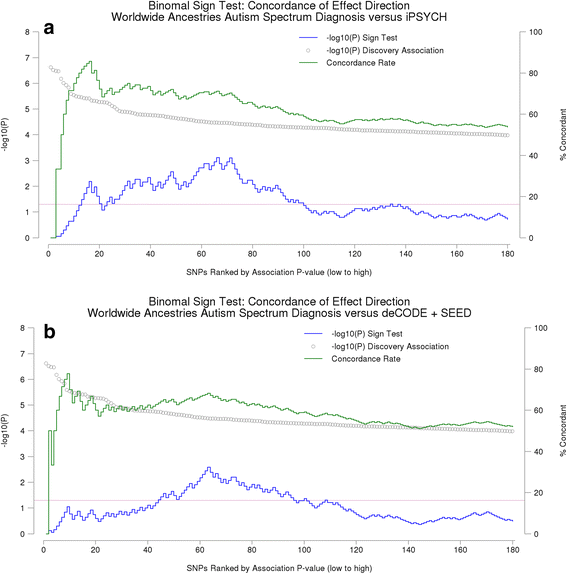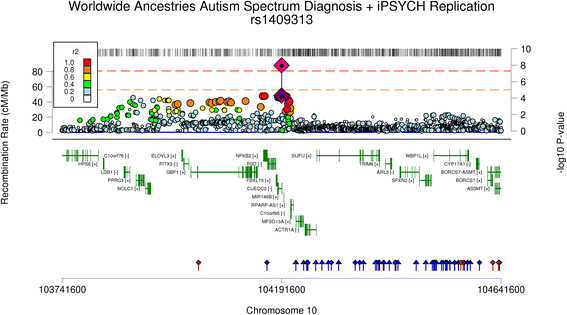Meta-analysis of GWAS of over 16,000 individuals with autism spectrum disorder highlights a novel locus at 10q24.32 and a significant overlap with schizophrenia
- PMID: 28540026
- PMCID: PMC5441062
- DOI: 10.1186/s13229-017-0137-9
Meta-analysis of GWAS of over 16,000 individuals with autism spectrum disorder highlights a novel locus at 10q24.32 and a significant overlap with schizophrenia
Abstract
Background: Over the past decade genome-wide association studies (GWAS) have been applied to aid in the understanding of the biology of traits. The success of this approach is governed by the underlying effect sizes carried by the true risk variants and the corresponding statistical power to observe such effects given the study design and sample size under investigation. Previous ASD GWAS have identified genome-wide significant (GWS) risk loci; however, these studies were of only of low statistical power to identify GWS loci at the lower effect sizes (odds ratio (OR) <1.15).
Methods: We conducted a large-scale coordinated international collaboration to combine independent genotyping data to improve the statistical power and aid in robust discovery of GWS loci. This study uses genome-wide genotyping data from a discovery sample (7387 ASD cases and 8567 controls) followed by meta-analysis of summary statistics from two replication sets (7783 ASD cases and 11359 controls; and 1369 ASD cases and 137308 controls).
Results: We observe a GWS locus at 10q24.32 that overlaps several genes including PITX3, which encodes a transcription factor identified as playing a role in neuronal differentiation and CUEDC2 previously reported to be associated with social skills in an independent population cohort. We also observe overlap with regions previously implicated in schizophrenia which was further supported by a strong genetic correlation between these disorders (Rg = 0.23; P = 9 × 10-6). We further combined these Psychiatric Genomics Consortium (PGC) ASD GWAS data with the recent PGC schizophrenia GWAS to identify additional regions which may be important in a common neurodevelopmental phenotype and identified 12 novel GWS loci. These include loci previously implicated in ASD such as FOXP1 at 3p13, ATP2B2 at 3p25.3, and a 'neurodevelopmental hub' on chromosome 8p11.23.
Conclusions: This study is an important step in the ongoing endeavour to identify the loci which underpin the common variant signal in ASD. In addition to novel GWS loci, we have identified a significant genetic correlation with schizophrenia and association of ASD with several neurodevelopmental-related genes such as EXT1, ASTN2, MACROD2, and HDAC4.
Keywords: Autism spectrum disorder; Gene-set analysis; Genetic correlation; Genome-wide association study; Heritability; Meta-analysis; Neurodevelopment; Schizophrenia.
Figures


References
Publication types
MeSH terms
Substances
Grants and funding
- U24 MH081810/MH/NIMH NIH HHS/United States
- U10 DD000180/DD/NCBDD CDC HHS/United States
- R01 MH100027/MH/NIMH NIH HHS/United States
- R01 CA094143/CA/NCI NIH HHS/United States
- P01 CA095616/CA/NCI NIH HHS/United States
- U10 DD000182/DD/NCBDD CDC HHS/United States
- R01 MH094293/MH/NIMH NIH HHS/United States
- U10 DD000181/DD/NCBDD CDC HHS/United States
- R01 MH097849/MH/NIMH NIH HHS/United States
- K99 MH101367/MH/NIMH NIH HHS/United States
- R01 MH060007/MH/NIMH NIH HHS/United States
- R56 MH097849/MH/NIMH NIH HHS/United States
- U10 DD000184/DD/NCBDD CDC HHS/United States
- CIHR/Canada
- MR/P005748/1/MRC_/Medical Research Council/United Kingdom
- U01 DD000498/DD/NCBDD CDC HHS/United States
- U01 MH109514/MH/NIMH NIH HHS/United States
- P50 CA095817/CA/NCI NIH HHS/United States
- R00 MH101367/MH/NIMH NIH HHS/United States
- R01 MH081754/MH/NIMH NIH HHS/United States
- WT_/Wellcome Trust/United Kingdom
- U01 MH109539/MH/NIMH NIH HHS/United States
- U01 MH094421/MH/NIMH NIH HHS/United States
- U10 DD000183/DD/NCBDD CDC HHS/United States
- U01 MH094432/MH/NIMH NIH HHS/United States
- MR/L010305/1/MRC_/Medical Research Council/United Kingdom
LinkOut - more resources
Full Text Sources
Other Literature Sources
Medical
Miscellaneous

